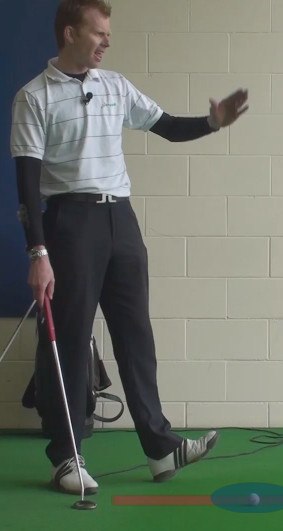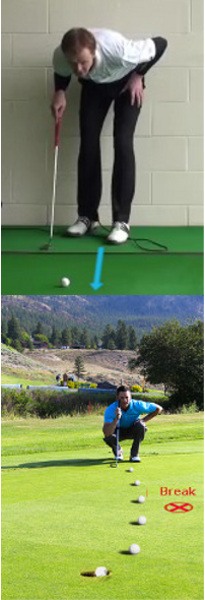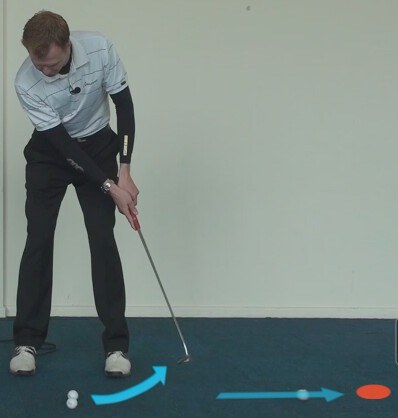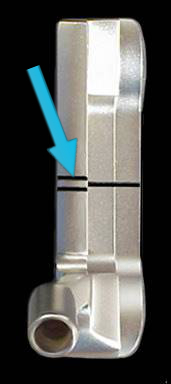A small misalignment on a full golf shot can cause the ball to veer off-target by several yards. Poor aim with your putter will have a negligible effect on direction, but the minute margin for error magnifies the mistake.
Aligning the putter's face with the target line is critical for the obvious reason, but also because chronic misalignment makes the golfer subconsciously compensate during the stroke. For instance, if you consistently line up left of the hole without realizing it, you'll develop a stroke that pushes the ball back on line.
Fortunately, proper aiming is simple thanks to built-in guides featured on the majority of today's putters. While some have only a single line atop the putter head, others offer a more sophisticated system that ensures correct aim with the eyes directly over the ball.
Even with a helpful putter, you must be able to choose an aiming spot and point the putter at it. Here's a highly effective method: 
- Read your putt's break (curve) and speed.
- If the putt is straight, your target is the hole.
- If the putt breaks, pick the spot where it will begin turning toward the hole (aka the high point of the break).
- Place the ball so that its alignment aid – such as the name brand or other marking – points directly at your target.
- Place putter behind ball, matching the alignment guides.
If you've been lining up incorrectly, proper alignment may look off the mark when you stand over the ball.
If so, you'll need to practice diligently to gain a feel for the right line and to banish bad stroke habits you may have formed.
Thomas Golf offers custom-built putters, with state-of-the-art alignment aids, through its website (www.thomasgolf.com).

How to Aim Your Putter
Making putts is the difference between shooting a decent score for the day and posting one of your best rounds. The ball striking that you are able to bring to the course will determine the general range of scores that you can shoot, but it is your putting that will have the final say on the score that you write down on your card. For example, your ball striking may dictate that you are going to shoot a score somewhere in the 80's – but is it going to be an 81, or an 89? There is a big difference in those two scores, and that gap can usually be explained entirely by putting. No matter what level of player you happen to be, putting is forever going to remain a critical piece of the golf puzzle.
There are a number of elements that have to come together in order for you to make a putt. First, of course, you have to make the right read. You have to judge the speed of the green correctly, and the mechanics of your putting stroke have to be in order. Also, you need to hold your nerve and not allow the pressure of the moment to cause a breakdown in your mechanics. In addition to all of that, you will need to aim your putter correctly when you stand over the ball – and that point is going to be the focus of the content below. After all, making a great read and a great stroke isn't going to do you any good at all if you aren't able to actually aim at your intended target. Only when you can aim as you intend each and every time will you be able to live up to your putting potential.
Aiming your putter might seem like something that you don't even need to think about – doesn't it just happen automatically? Well, no, it doesn't, and you are probably making more aiming errors than you are aware of currently. In fact, some of the missed putts in your recent rounds that you have attributed to a faulty stroke or a bad read were probably just the end result of incorrect aim. Most golfers tend to blame their misses on either the stroke or the read, when in reality, many missed putts at the amateur level start out with improper aim. If you can manage to aim your putter correctly prior to making a stroke, you just might be surprised at how many of your putts find their way to the bottom of the cup.
All of the content below is based on a right handed golfer. If you happen to play left handed, please take a moment to reverse the directions as necessary.

The All-Important Target Line
When you aim your putter, it should be aimed down the target line that you have selected for the putt – you have selected a target line, correct? Without picking a target line, your putt will have almost no chance of success. Sadly, many amateur golfers fail to consistently pick a target line when they stand over the ball at address, and they pay the price when the ball rolls by the cup on one side or the other.
Of course, in order to pick a target line, you have to know what that term means as it relates to putting. Contrary to popular belief, the target line for your putt is not a line directly from your ball to the hole. Well, it could be, but usually it is not. The target line is the line that you have picked out for the start of the roll. Based on the break that you expect in the putt, you will use a target line that allows the ball to curve (hopefully) into the hole. On a perfectly straight putt, the target line would indeed be a line that goes directly from your ball to the hole. Most putts have some degree of break, however, so your target line is usually going to be at least slightly to the right or left of the cup.
This concept will be better illustrated by an example. Picture a ten foot putt that is running across a slope which is tilted from right to left. Based on the severity of the slope, you are expecting the putt to break six inches as the ball rolls from its current location all the way to the hole. Therefore, your target line will aimed at a point which is six inches to the right of the hole. If you are able to hit this line with your putt, and you read the break correctly, the ball should fall in to the hole more often than not.
The idea of a target line on the putting green is much the same as it is off the tee or from the fairway, where you are aiming to the right or left to account for the curve of your ball in the air. Obviously you can't hit a hook or a slice when you are putting, but you need to account for curve in much the same way because of the slope on the green. Many amateur golfers are unable to separate the idea of hitting the ball at the hole with the concept of the target line, and therefore they 'steer' the ball toward the hole even when they know the putt is going to break along the way. If you are going to succeed on the putting green, it is incredibly important that you manage to trust your target line. Believe in the read that you have made, and do your best to roll the ball on your selected target line – the slope of the ground should do the rest.
So, getting back to the concept of aiming your putter, it is the target line that you are going to have in mind when you are aiming your putter head at address. This line will occasionally match up with a line that goes directly to the hole (on a straight putt), but it will usually be at least slightly right or left of the hole to play the break. In extreme cases on steep greens, you may have to aim several feet to one side or the other in order to give your ball a chance to go in. If you have not yet learned how to pick a quality target line while putting, work on that skill first before you concern yourself with the ability to aim. After you have nailed down the idea of how to pick a good target line, you can then move on to the aiming part of the putting equation.

The Aiming Process
Building a routine is going to be your easiest path to success as far as aiming your putter is concerned. If you go about setting up for your putts in the same way each time, you will be far more likely to aim properly down the target line. Many players are inconsistent in the way they approach the ball, making it nearly impossible to align the putter head correctly time after time. Once you learn how to use a routine to place the putter in the right position, you will see just how easy the task of aiming your putter can be.
The step-by-step process below will walk you through the correct way to get lined up before each putt. While it is okay to vary from this process slightly to suit your own personal preferences, you should stick to something similar to this framework.
- The first step in the process is to assess the kind of putt you are facing, and to determine your exact read. This will take a bit of time, but make sure to keep it moving so that you avoid slowing down play for everyone else. You should take a look at your putt from behind the ball, as well as from behind the hole (if you have time). Once you have assessed the slope of the green, select the target line that you are going to use for the putt.
- Now that you have your target line picked out, it is time to set up to hit the putt. The best way to start this process is to stand behind your ball looking down the line toward the cup. Rather than looking on a line directly from the ball to the hole, focus your eyes on the target line that you selected. Everything from here on out is about the target line, so that is where your eyes should be looking.
- With the target line directly in your sights, walk from behind the ball up into position next to the ball. As you approach the ball, the first thing you should do is place the putter head behind the ball with the face pointing generally in the direction of your target line. Important note – do not set your feet into your stance immediately upon walking up to the ball! Setting your feet will actually be one of the last things that you do in this process, so just stand casually next to the ball at this point while focusing on the putter head.
- Now that the putter head is on the ground behind the ball, it is time to confirm your aim by squaring up the putter head to your target line perfectly. Use any aim aids that are on the top of your putter – such as lines or shaded areas – and make sure you are happy with your aim before moving forward. Of course, once the putter is correctly aligned with your target line, make sure that the putter head does not move prior to actually hitting the putt.
- Taking your stance is the next, and final, step in this process. Now that the putter head is pointed in the right direction, move your feet into position and get comfortable prior to making the stroke. Your knees should be slightly bent, your eyes should be on the ball, and your grip should be relaxed. Once you feel like you are in the correct position to make a good stroke, take one last look at the hole and then let it go.
Reading through the list above could leave you feeling like it will take a few minutes to prepare to hit a single putt, but that really isn't the case. Once you have a little bit of practice under your belt, you should be able to run through these steps rather quickly – and without having to even think about them consciously. Just like anything else in golf, the routine you use to aim correctly with the putter is going to get better and better with practice. Therefore, make sure you work on this skill on the practice putting green so that it is ready to go when you head out onto the course.

The Power of Conviction
There is a lot to be said in the game of golf for the power of believing in yourself. Whether you are standing on the tee facing an intimidating tee shot over the water, or you are standing over a three-foot putt that you need to make in order to win a match, golf is a game that is all about confidence. Just as you need to have confidence in the swings and strokes that you are making, you also need to believe in the target line that you pick out for each of your putts. Picking out the right line is only going to allow you to make the putt if you actually trust that you are, in fact, looking at the right line. If you stand over the ball and doubt yourself before making the stroke, the outcome of your putt is almost certain to be a bad one. The players who can summon the conviction necessary to believe in their target line each and every time are those who will make the most putts.
So how do you manage to find the confidence within yourself to believe in your target lines? Well, first of all, you need to spend time on the practice green learning how to read your putts accurately. Confidence is always going to be a product of repetition, so working on this skill in practice will naturally carry over onto the course. As you see one putt after the next roll right into the cup on the practice green, you will start to realize that there is no reason why you can't be successful on the course as well. Many amateur golfers make the mistake of overlooking putting practice because they are too busy hitting as many balls as possible out on the range. Of course, this is a mistake, and it will never allow you to become the well-rounded golfer that you need to be in order to shoot good scores. If you can make it a habit to take time out of your practice session specifically for learning how to read putts, you will be amazed at the progress you can make in your game.
Another way you can gain conviction on the putting green is by taking your time to go through all of the necessary steps prior to hitting a putt. If you are standing over the ball after only taking a quick glance at the slope of the green, you are naturally going to wonder if you have the right line – because you haven't done the necessary homework. In many ways, this is like going to school without having studied for a test. You will be nervous and doubtful about how you can perform on the test because you know you didn't study properly in advance. If you are going to have confidence in the line you pick, you must take a moment to read your putt carefully before ever taking your stance.
The last point that needs to be made about having confidence in your line is the fact that there are actually multiple lines that could be successful on any given putt. The hole is significantly wider than the ball itself, meaning you have some margin for error when rolling the ball toward the hole. Sure, the hole can feel small at times when you are struggling with the putter, but there is plenty of space for the ball to fall in as long as you give it a chance. As you are standing over the ball getting ready to hit a putt, remember that you have a little bit of margin for error – so you don't have to require yourself to be perfect. Have confidence in the read you have made, give the putt your best stroke, and expect it to fall right in the center.

Hitting Your Target Line
Hopefully, with the help of the information above, you will be able to successfully improve on your ability to aim at the target line time after time. Unfortunately, that is not where this conversation ends. Setting up with the putter face perfectly aligned at the target is one thing – actually hitting that target line is another thing altogether. When the putter starts to move, bad things can happen. If your stroke is a little bit out of 'whack', you could find yourself sending your putts off line consistently, even if you aimed properly in the first place.
So, with that in mind, let's take a quick look at some of the keys to making a putting stroke that will send the ball down the target line that you worked so hard to find.
- Keep your body still. Body movement during the putting stroke is unnecessary, and it will cause the putter to swing off line. While the putter is moving back and through in the stroke, the parts of your body that are not being used to move the putter should be perfectly still. That means that your legs, hips, torso, and head should all be holding steady while your shoulders and arms rock back and forth. When done correctly the stroke will feel beautifully simple and the ball will start on line time after time.
- Light grip pressure. This point was mentioned briefly earlier, and it bears repeating. If the putter is going to swing freely through the ball as it should, you are going to need to use a light grip pressure all throughout the stroke. Put just enough pressure on the grip of the club to control it properly, but no more. You don't need much grip pressure to control a putter that is swinging relatively slowly through the ball, and keeping the club light in your hands will do wonders for the path of your stroke.
- Eyes on the ball. One of the first tips you likely received when you started playing golf remains one of the most important. As you stand over the ball at address, keep your eyes trained on the ball – and don't look away until after the ball has left the face of your putter. It takes discipline to keep your eyes on the ball while making a stroke, but that is exactly what you will do if you want to hit the target line. To practice this fundamental element of putting, try hitting a series of three foot putts on the practice green where you never look up at all – you just listen for the ball to drop in the cup. If you can master that technique, you should be able to keep your head down while putting on the course.
Aiming your putter properly is one of the key, basic fundamentals of the game of golf. Take the time to learn how to get lined up correctly on the practice green, and then use the same routine you build in practice to guide your play on the course. Unlike with a swing change that may take months or years to kick in, improving your putter aim is something that could pay off in the very next round you play.







